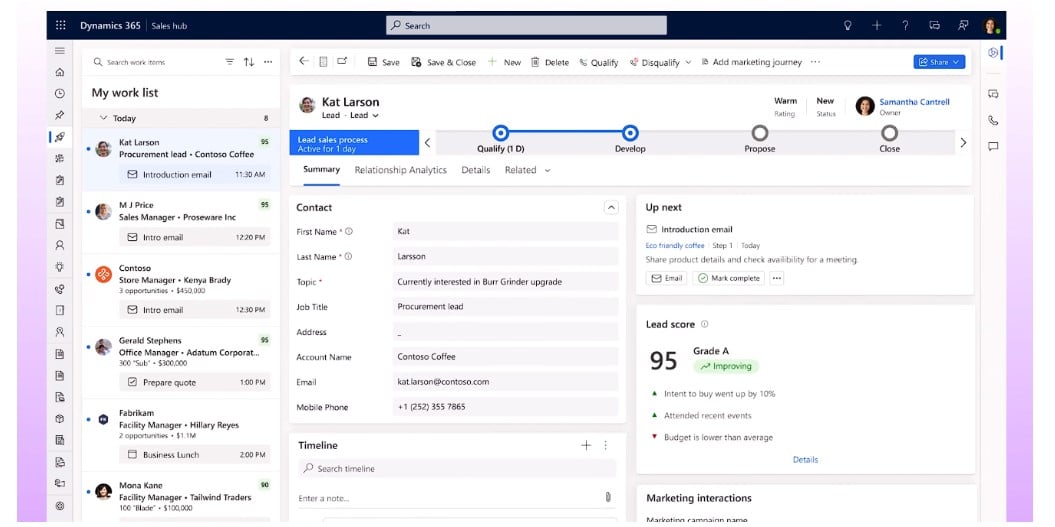An essential component of achieving brand coherence and aligning communication efforts with business goals is the implementation of an integrated communication strategy. Adopting a strategic approach can help to ensure uniformity across all channels while taking into account the intricacies of reaching target audiences.
In the world of technology in communications and digital transformation in PR, an integrated strategy can mean the difference between effective and poor communication. It can help you efficiently and effectively deliver the right messages to your target audience. By honing in on who should receive the message and explaining why it is pertinent to them, you can establish a meaningful connection.
In this article, I’ll discuss the role of technology in integrated communications and how you can make the most of tech-enabled communication strategies.
Let’s get right into it!
Technological Advancements in Communication
Navigating the forefront of communication technologies involves a strategic embrace of cutting-edge tools, particularly when it comes to PR. There are many innovative advancements to tap into, such as:
- Artificial Intelligence (AI)
- Machine Learning (ML)
- Big Data and analytics
Embracing AI and ML technologies in communication strategies can revolutionize the landscape of PR. These sophisticated tools can empower you to sift through vast amounts of data, extracting valuable insights and trends that might otherwise remain hidden.
Automated analysis of media coverage, social media sentiments, and audience behaviors can also make it easier for you to gain a nuanced understanding of your audience’s preferences, enabling you to tailor communication strategies with precision.
Additionally, AI-powered chatbots and virtual assistants are transforming the way organizations interact with their audience. These intelligent systems facilitate real-time engagement, providing instant responses to queries and ensuring a seamless communication experience—one of the top benefits of technology in communications.
Whether it’s addressing customer inquiries or managing crisis communications, AI and ML contribute to efficiency, allowing PR teams to focus on strategic, high-impact tasks.

AdmitHub mascot bot is straightforward but does a fantastic job at helping collect the necessary contact information, as well as the intent and goals prospects wish to achieve.
Big Data and advanced analytics have also ushered in a new era of strategic decision-making in PR. By harnessing the power of Big Data, you can gain comprehensive insights into audience behaviors, industry trends, and the effectiveness of communication campaigns. This data-driven approach enables agile decision-making, allowing for quick adjustments based on real-time feedback.
Analytics tools provide the capability to measure the success of PR initiatives quantitatively. Metrics such as engagement rates, sentiment analysis, and reach metrics offer a holistic view of campaign performance.
Communication channels for businesses have also shifted from traditional methods like faxes and landline phones to the dynamic realm of today’s social media platforms. Embracing these innovative tools not only reflects a departure from outdated practices but also unlocks a host of enhanced business benefits.
Transformative Role of Technology in PR and Media Relations
As technology continues to reinvent itself, here’s the impact it can have on PR and media relations. Learn how technology can play a transformative role and reshape the way you communicate and engage with your audience.
Automation and Streamlining in Public Relations
AI and automation can be awesome for PR professionals, offering a streamlined approach to various facets of their work and delivering a substantial boost to productivity.
Leveraging sophisticated algorithms, AI-powered software can analyze extensive datasets sourced from diverse outlets, including social media, news platforms, and consumer interactions.
Through the meticulous monitoring and interpretation of this data, AI can be a valuable ally for PR practitioners, offering profound insights into audience preferences, sentiment trends, and emerging topics. Equipped with this knowledge, you can craft campaigns with exceptional precision, ensuring that their messaging resonates precisely with the targeted audience.
In contrast to the labor-intensive nature of traditional methods, AI-driven tools now excel in efficiently tracking mentions, gauging sentiment, brand monitoring, and assessing brand visibility across multiple platforms in real-time. This newfound capability can make it easier for you to promptly address any unfavorable publicity or leverage positive mentions, thereby fortifying and enhancing your brand reputation.

Brand monitoring tools can give you insight into what people are saying about your company, allowing you to adjust PR campaigns.
Tech-Driven Media Outreach and Engagement
Media outreach can serve as a cornerstone in public relations and help you to get your messages to a broader audience.
Through strategic engagement with journalists, bloggers, and influencers within your industry, facilitated by innovative PR technologies, you can secure media coverage that extends to a wider audience previously unaware of your brand.
One technological advancement stands out when it comes to PR communication—video chats, messages, and conferences. This innovation not only personalizes interactions for individuals but also revolutionizes communication for businesses.
Video conferences can facilitate a more immersive understanding of ongoing activities, offering a visual medium to interpret charts, data, presentations, and more. This transformative technology enhances the depth and clarity of communication, fostering meaningful connections.
You can also learn to use AI in video creation, incorporating video into PR strategies in easier and more efficient ways. With AI, you can enhance visual effects and audio effects, automating editing, and refining analytics.
Enhancing Media Relations through Digital Platforms
Digital PR is a strategic promotional tactic that can elevate the online presence of a brand. It can catalyze driving brand awareness, augmenting website traffic, establishing valuable links to enhance organic rankings, and catalyzing measurable outcomes in terms of online sales, social following, and engagement.
Operating seamlessly within the overarching framework of marketing ideas and communications goals, digital PR has undergone a transformative evolution in tandem with technological advancements.
Historically rooted in traditional media outreach, focusing on newspapers, television, and radio, the traditional PR landscape thrived on networking and cultivating long-term relationships with journalists.
However, the advent of the digital era precipitated a shift in PR strategies. The scope broadened to encompass a wider audience, driven by the growth of social media.
Platforms like X (Twitter), Facebook, and Instagram facilitated the amplification of brand messages, fostering real-time interactions and immediate feedback. In this new landscape, PR practitioners gained the ability to extend their reach through diverse channels, including websites, emails, podcasts, and blogs.
With such a tech-driven strategy, you can delve into identifying who your target audience is and strategically determine how and where to engage with them. You may even consider using software for website localization to make sure you’re reaching your audience with the right content.
Also, the dynamic nature of digital PR enables swift adaptation to the latest trends, a practice exemplified by ‘newsjacking.’ Leveraging the real-time nature of digital platforms, you can tap into ongoing conversations or breaking news to amplify your brand’s message.
By vigilantly monitoring trending topics, news stories, or industry-specific discussions, PR teams can craft content that is both timely and relevant, seamlessly aligning with the prevailing conversations in the digital sphere.

Google Trends is an example of a useful tool for monitoring trends and hot topics that can be used to build PR campaigns.
Digital Tools and Platforms Revolutionizing Integrated Communications
The landscape of integrated communications has been significantly transformed by the advent of various digital tools and platforms.
These technological advancements play a pivotal role in enhancing the efficiency, reach, and impact of integrated communications strategies.
Role of Social Media in Integrated Communication Strategies
Social media offers many brilliant opportunities for strategic brand engagement. Beyond its conventional roles in inbound and word-of-mouth marketing, as well as paid advertising and customer insights, social media holds additional dimensions that significantly contribute to a brand’s success.
One pivotal aspect lies in the ability to foster meaningful conversations with customers. The profound truth remains—people prefer to buy from brands they know and trust. A staggering statistic underscores this reality: 90 percent of customers are inclined to purchase a brand they follow on social media.
A company can shape customer and stakeholder perception through its social media presence. A good example of a good social media strategy comes from KFC—the brand not only uses its platforms for PR-related communications but also creates content that people can relate to. This funny meme is just one example of KFC using social media the right way:

This funny meme is just one example of KFC using social media the right way. Incorporating such engaging and relatable content into your marketing plan ensures a holistic approach to brand communication through social media.
Content Management Systems and Collaboration Tools
A content management system (CMS) is a specialized software crafted for the seamless publishing and administration of website content. The inherent design of content management systems emphasizes user-friendliness, catering to individuals without technical expertise.
Content management systems furnish the essential tools to translate collaboration from an abstract concept into tangible reality.
Ensuring that your team operates in a coordinated manner not only boosts efficiency and organization but also fortifies the trust among individuals striving towards shared PR goals.
Digital Monitoring and Analytics for Communication Measurement
Harnessing technology for targeted and personalized communication measurement involves leveraging advanced tools and analytics to assess the effectiveness of communication strategies in a highly granular and individualized manner.
Technology enables the collection and analysis of vast amounts of data related to audience behavior, preferences, and interactions. Through sophisticated analytics, communicators can segment audiences based on various criteria, allowing for targeted communication to specific demographics, interests, or behaviors.
CRM systems help organizations manage and analyze interactions with current and potential customers. By integrating communication data into CRM systems, organizations gain insights into individual customer journeys, enabling personalized communication based on historical interactions.

On top of that, personalization engines use algorithms to tailor content based on user preferences, behavior, and historical interactions. By incorporating personalization into communication strategies, organizations can deliver content that resonates with individual recipients, increasing engagement and response rates.
Email marketing can also be a robust tool for personalized communication. Employ email automation and segmentation techniques to craft customized email newsletters that speak directly to each recipient’s unique interests and requirements. This may encompass tailored product recommendations, exclusive offers, and pertinent content designed to resonate with individual preferences.
Personalization through Data-Driven Communication
Data-driven communication involves the strategic utilization of pertinent and dependable data to shape, influence, and captivate your audience. This practice extends beyond mere information dissemination. It also covers:
- the crafting of compelling messages
- tailoring content to distinct segments
- assessing the efficacy of communication efforts through measurable outcomes
Personalization through data-driven communication is a strategy that involves tailoring messages, content, and interactions to individual preferences, behaviors, and characteristics.
By leveraging relevant and reliable data, organizations can create highly targeted and personalized communication experiences for their audience.
Targeting Audiences Using Segmentation and Tech-Enabled Strategies
Audience segmentation serves as a strategic approach that directs a program’s focus toward the most pivotal members of the audience, ensuring the design of an effective and efficient strategy for encouraging each segment to adopt new behaviors.
This method allows programs to align audiences, messages, media, products, and services with the specific needs and preferences of each segment. Audience segmentation seamlessly integrates with the broader process of audience analysis, ensuring a cohesive and informed approach.
Impact of Technology on Customer-Centric Communication
In recent years, the influence of technology on customer-centric communication has been substantial, prominently exemplified by the surge in self-service options. Customers now possess the capability to independently seek answers and resolve issues through online forums, FAQs, and chatbots.

The integration of self-service options significantly expedites issue resolution, allowing customers to address common queries autonomously, thereby enhancing efficiency. This not only contributes to efficient problem-solving but also plays a crucial role in fostering customer loyalty.
The strategic redirection of human resources to manage escalated complaints and navigate emotionally charged situations stands as a pivotal factor in enhancing the overall quality of customer service interactions.
Unlocking Potential: Technology’s Role in Shaping PR Strategies
There is an intricate interplay between technology and PR with a resounding theme—the need for agility, adaptability, and an unwavering commitment to understanding and meeting the evolving expectations of diverse audiences. Personalized communication, made possible by cutting-edge tools and platforms, takes center stage.
For the PR industry, this means a shift from traditional methodologies to an embrace of dynamic, data-driven, and digitally integrated strategies. It signifies a departure from one-size-fits-all approaches to a personalized and audience-centric ethos.
Your success hinges on your ability to not only embrace technological innovations but to harness them strategically, enhancing engagement, fostering trust, and delivering messages with unparalleled precision.
Getting your PR strategy right requires a lot of careful planning and the right tools. Embrace technology in PR communications and discover how the right strategies can take your business to the next level.








